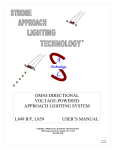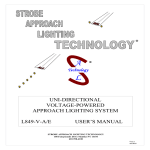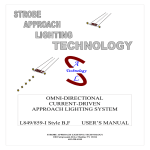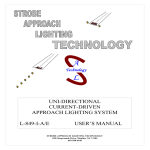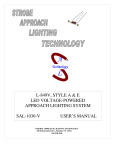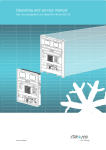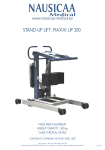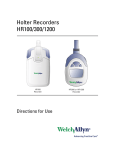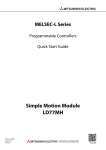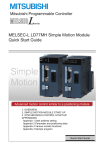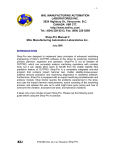Download uni-directional current-driven approach lighting system psuc
Transcript
TM A Technology L UNI-DIRECTIONAL CURRENT-DRIVEN APPROACH LIGHTING SYSTEM PSUC-103/104 USER’S MANUAL STROBE APPROACH LIGHTING TECHNOLOGY 108 Fairgrounds Drive Manlius NY 13104 603-598-4100 V 1.2.1a SCOPE This manual contains Installation, Operation, and Maintenance information for Unidirectional Runway Approach Lights manufactured by Strobe Approach Lighting Technology™ (SAL Technology™), Manlius, NY, USA. CARTON LABELING Each carton contains one complete light consisting of a power supply and a flash head. The contents are identified by external labeling. A REIL system typically consists of two cartons, one labeled Master and the other labeled Slave. A system of sequential lights requires at least one carton for each light, and one of the cartons will be identified as Master. The remaining cartons containing Slave units are identified as Light #2, Light #3, and so on. The Master unit is considered to be Light #1. Some systems may have accessory items that require separate packaging. Those packages are also appropriately identified. In addition to a power supply and flash head, each carton contains two frangible fittings with short EMT couplings for power supply installation. An Owner’s Manual is included in the carton containing the master unit. UNPACKING Inspect each shipping carton for external damage immediately upon receipt. There could be damage to the contents if the carton is damaged. Promptly file a claim with the freight carrier if you have received damaged equipment. TOOLS RECOMMENDED #2 Phillips screwdriver; 10-inch shank. 1/4-inch, flat blade screwdriver; 10-inch shank. 1/8-inch, flat blade screwdriver; short shank (for circuit board potentiometer adjustments). Water pump pliers opening to 3-inches (for 2-inch EMT compression fittings). Wire strippers. Wire cutters (for small gage wire). Volt-Ohm meter; 1000-volt range. ABBREVIATIONS USED IN THIS MANUAL PSUV → Power Supply Unidirectional Voltage (driven) FHUD → Flash Head Uni-Directional REIL → Runway End Identifier Lights ALS → Approach Lighting System SLC → Series Lighting Circuit NPT → National Pipe Tapered (thread) EMT → Electrical Metallic Tubing i PSUC-103/104 04/07/13 V 1.2.1a DISCLAIMER The information in this manual is believed to be accurate and up to date, however, Strobe Approach Lighting Technology™ assumes no liability for damages or injuries that may result from errors or omissions, or from the use of information presented herein. Strobe Approach Lighting reserves the right to modify this manual at its discretion without notification to any person or organization. APPLICABLE SPECIFICATIONS This equipment meets or exceeds the requirements in the FAA Advisory Circular, AC 150/534551, and is listed as FAA approved equipment in AC 150/5345-53, Addendum. WARRANTY Strobe Approach Lighting Technology warrants this equipment and all of its components, when used under normal conditions. Failure of any component within one year from the date of shipment will be corrected by repair or replacement, FOB Manlius, NY 13104. USE OF GENERIC PARTS Using parts not manufactured or supplied by Strobe Approach Technology or unauthorized modification of any part of this equipment, voids the warranty and could render the equipment noncompliant with applicable FAA specifications. CONTACT INFORMATION Strobe Approach Lighting Technology may be contacted by the following methods: Tele: 603-598-4100 Fax: 603-598-4198 Email: [email protected] WARNING Dangerous Voltages This equipment generates voltages that are dangerous to personnel. Use appropriate caution while operating or servicing this equipment. Capacitors can retain a substantial charge even after power has been removed. Allow at least one minute after turning off the power for the capacitors to be drained of charge–then check the safety lamps inside provided for this purpose. Do Not Depend on Interlocks Never depend on an interlock switch alone to render the equipment safe. Always look for the condition of the High Voltage Indicating Lights and check circuits with a voltmeter. Do not disable the safety interlock switch. ii PSUC-103/104 04/07/13 V 1.2.1a TABLE OF CONTENTS Page Front Matter ----------------------------------------------------------------------------------------------------- i-iv Carton Labeling -------------------------------------------------------------------------------------------- i Unpacking -------------------------------------------------------------------------------------------------i Tools Recommended -------------------------------------------------------------------------------------- i Abbreviations Used In This Manual -------------------------------------------------------------------- i Applicable Specifications --------------------------------------------------------------------------------- ii Warranty ---------------------------------------------------------------------------------------------------- ii Use of Generic Parts --------------------------------------------------------------------------------------- ii Contact Information --------------------------------------------------------------------------------------- ii Table of Contents ------------------------------------------------------------------------------------------ iii List of Figures ---------------------------------------------------------------------------------------------- iv List of Tables ----------------------------------------------------------------------------------------------- iv Abbreviations ----------------------------------------------------------------------------------------------- iv General Description -------------------------------------------------------------------------------------------- 1 Access ------------------------------------------------------------------------------------------------------------ 1 Equipment Specifications ------------------------------------------------------------------------------------- 2 Installation ------------------------------------------------------------------------------------------------------- 3-5 Mounting the Power Supply ------------------------------------------------------------------------------ 3 Power Hookup --------------------------------------------------------------------------------------------- 4 Control Line Hookup -------------------------------------------------------------------------------------- 5 Functional Description ---------------------------------------------------------------------------------------- 6 Applications ----------------------------------------------------------------------------------------------------- 6 Programming ---------------------------------------------------------------------------------------------------- 7 Setup Procedures ----------------------------------------------------------------------------------------------- 8-11 Three Levels of Intensity From a 3-Step CCR -------------------------------------------------------- 9 Three Levels of Intensity From a 5-Step CCR -------------------------------------------------------- 10 Single Intensity Setup ------------------------------------------------------------------------------------ 11 Theory of Operation ------------------------------------------------------------------------------------------- 12 Maintenance ----------------------------------------------------------------------------------------------------- 13 Troubleshooting ------------------------------------------------------------------------------------------------ 14-18 Status Lights ---------------------------------------------------------------------------------------------15 Normal Indications ---------------------------------------------------------------------------------------- 16 Problems At Installation----------------------------------------------------------------------------------- 17 Evolving Problems ---------------------------------------------------------------------------------------- 18, 19 Replacing Flash Head Components -------------------------------------------------------------------------- 20-22 Flash Lamp ------------------------------------------------------------------------------------------------- 20, 21 Trigger Transformer --------------------------------------------------------------------------------------- 21, 22 Replaceable Parts ----------------------------------------------------------------------------------------------- 23 iii PSUC-103/104 04/07/13 V 1.2.1a LIST OF FIGURES PAGE 1a: Power Supply --------------------------------------------------------------------------------------------- 1 1b: Flash Head ------------------------------------------------------------------------------------------------ 1 1c: Flash Head ------------------------------------------------------------------------------------------------ 1 2: Typical Mounting Details --------------------------------------------------------------------------------- 3 3: Electrical Connections ------------------------------------------------------------------------------------ 4 4: Control Line Connections -------------------------------------------------------------------------------- 5 5a: PCB-1 Photo ---------------------------------------------------------------------------------------------- 6 5b: Programming Switches ---------------------------------------------------------------------------------- 6 6: Circuit Board Programming ------------------------------------------------------------------------------ 7 7: Current Sensing Adjustments ---------------------------------------------------------------------------- 8 8: Flash Head Sealing ---------------------------------------------------------------------------------------- 13 9: Power Supply Component Identification --------------------------------------------------------------- 14 10: Flash Head Component Identification ----------------------------------------------------------------- 14 11: PCB-1 Status Lights-------------------------------------------------------------------------------------- 15 12: PCB-2: Status and Safety Lights ----------------------------------------------------------------------- 15 13a: Flash Head Front View --------------------------------------------------------------------------------- 20 13b: Flash Lamp Terminals --------------------------------------------------------------------------------- 20 14a: Flash Head Bracket ------------------------------------------------------------------------------------- 21 14b: Trigger Transformer Replacement ------------------------------------------------------------------- 21 13: Component Location Diagrams ------------------------------------------------------------------------ 23 LIST OF TABLES Table 1: Three-Step CCR -----------------------------------------------------------------------------------Table 2: Five-Step CCR -------------------------------------------------------------------------------------Table 3: Relay Mode Conditions --------------------------------------------------------------------------Table 4: Replaceable Parts ----------------------------------------------------------------------------------- 8 8 19 23 iv PSUC-103/104 04/07/13 V 1.2.1a GENERAL DESCRIPTION A flashing runway approach light from SAL Technology™ consists of a power supply and a flash head. A power supply (Figure 1a) may be either a master unit or a slave. The catalog designation for a Master power supply is PSUC-103. A Slave power supply is PSUC-104. The Flash Head (Figure 1b) in either case is FHUD-109. The flash head may be attached directly (co-mounted) to a power supply enclosure (Figure 1c) or installed separately and connected by up to 100 feet of suitable cable. The cable can be furnished by SAL Technology. This equipment is classified as a unidirectional discharge flasher (strobe) that operates from a Series Lighting Circuit driven by an L-828 Constant Current Regulator, Class 1, Style 1 or 2. This equipment does not require an intermediate Series Circuit Adapter. It is specifically designed and tested to meet the requirements for L-849I applications as defined in the FAA’s “Specification for Discharge-Type Flashing Light Equipment”, AC 150/5345-51A. L-849I is the designation used by the FAA for a current-driven flashing light for Runway End Identification Lights (REIL). L-849I lights from SAL Technology are certified by third party testing under the FAA’s Airport Lighting Equipment Certification Program (ALECP). These lights also meet the photometric and functional requirements for discharge flashers in a high or medium Intensity precision Approach Lighting System (ALS). Figure 1a Power Supply, PSUC-103 or 104 Figure 1c, Co-Mounted Unit Figure 1b Flash Head, FHUD-109 ACCESS The power supply cover is secured by quarter-turn latches with padlock provisions on the two front corners of the enclosure. A co-mounted unit also has two self-releasing latches across the hinge. The hinged cover when fully opened is supported by a lanyard. The flash head does not have to be accessed for installation, even if it is mounted separately. The front bezel can be removed to gain access to the flash lamp by loosening four captive screws. A plate secured by two captive screws at the rear of the housing allows access to other internal flash head components. 1 PSUC-103/104 04/07/13 V 1.2.1a EQUIPMENT SPECIFICATIONS PHYSICAL: Dimensions are in inches (mm); Weight in lbs (kg). PSUC-103 & 104, Power Supply, (Figure 1a). Dimensions ---------------------------------------------- 8H x 16W x 14D (203 x 406 x 356) Weight: --------------------------------------------------- 47(21.3) FHUD-109, Flash Head, (Figure 1b). Dimensions: --------------------------------------------- 11.5H x8.5W x7D (292 x 216 x 178) Weight: --------------------------------------------------- 4.5 (2) Power Supply and Flash Head (Co-mounted, Figure 1c). Dimensions: ----------------------------------------------19.5H x 16W x 14D (495 x 406 x 356) Weight: ----------------------------------------------------51.5 (23.3) OPERATIONAL: Current (rms Amps): ------------------------------------2.8 to 6.6 5.2 Amps Min. required for High intensity Power: (Watts) -------------------------------------------150 Ave, 290 Peak Flash Rate (Flashes Per Minute): ----------------------120 Intensity (Beam Limits, Effective Candelas): --------High: 8000 to 22500 Med: 800 to 2250 Low: 160 to 450 Beam Spread: ---------------------------------------------30º Horizontal, 10º Vertical. AVAILABLE OPTIONS: (Must be factory installed) Flash Monitoring Elapsed Time Meter 2 PSUC-103/104 04/07/13 V 1.2.1a INSTALLATION Installation consists of mounting the power supply onto previously prepared supports and making electrical connections. Some installation details could depend on site drawings and specifications originated by others. Basic requirements are given below. If you are installing a system with sequentially flashing lights you should place each light in its assigned position. Light #1 is intended to be nearest to the runway threshold. Light #2 is intended to be next, and so on. A light that has not been placed in its intended position can be reprogrammed using the information in Figure 6. MOUNTING THE POWER SUPPLY The power supply requires two, 2-inch NPT base supports at ground level such as NPT flanges anchored in concrete at a spacing of 8.00 inches center to center, or a burial can cover with threaded entrance holes at the required spacing. The power supply itself is provided with two attached, 2-inch, EMT compression fittings. Frangible fittings shipped with the equipment have male threads at one end and 2-inch EMT compression fittings at the other. Each one is furnished with a short (2-½ inch) length of EMT by which they may be coupled to the compression fittings on the bottom of the power supply enclosure. The frangible fittings must first be screwed into the ground supports and securely tightened. The EMT couplings must be adjusted to extend out of the frangible fittings by 3/4 to 1-inch and the compression nuts securely tightened. Set the power supply down over the two EMT couplings and securely tighten the compression nuts. A power supply with a co-mounted flash head meets the maximum height restriction set by the FAA when installed as described above and as shown in Figure 2. The 2-½ inch long EMT sections may be replaced by slightly longer sections if local conditions require raising the elevation of the light source by a few inches. This is not recommended for a substantial increase in light center elevation; mounting the flash head on a separate support while leaving the power supply close to the ground is recommended instead. Please note that separate flash head mounting is not intended as a field option. The method of flash head mounting should be specified when the equipment is ordered. POWER SUPPLY COMPRESSION FITTING SHORT EMT COUPLING 2-INCH NPT TO COMPATIBLE GROUND FITTING FRANGIBLE FITTING 8.00 INCHES Figure 2, Typical Mounting Details 3 PSUC-103/104 04/07/13 V 1.2.1a INSTALLATION (Cont.) PRIMARY POWER HOOKUP (See Figure 3). Each light requires an L-830–10 (300 watt) Isolation Transformer connecting the power supply to the Series Lighting Circuit. This transformer is normally supplied by others, although it can be purchased from SAL Technology and shipped with the equipment as an optional item. A 72-inch long L-823 Cord Set is provided as part of each power supply and pre-attached at the factory. The cord set has a molded plug compatible with the molded socket on the secondary winding of an L-830 transformer. The cord set is arranged to conveniently exit through the 2inch EMT support on the LEFT side of the power supply (as you face the opened cover). Connecting primary power therefore consists only of feeding the two-wire cord set through the EMT support and plugging it into the mating socket on the L-830-10 transformer. Each power supply should be grounded locally for protection against lightning damage. An external grounding lug on the bottom of the power supply enclosure is provided for this purpose. A grounding rod should be installed at each power supply for the best protection. GROUNDING THESE POWER SUPPLIES TO A COUNTERPOISE COULD INCREASE THE RISK OF DAMAGE DUE TO LIGHTNING SERIES LIGHTING CIRCUIT ADDITIONAL SLAVE UNITS (WHEN REQUIRED) L-830-10 ISOLATION TRANSFORMER L-823 CORD SET SUPPLIED WITH THE EQUIPMENT AND CONNECTED AT THE FACTORY) MASTER CONTROL LINE TWO AWG12 CONDUCTORS TWISTED TOGETHER SLAVE SLAVE GROUNDING ROD Figure 3, Typical Electrical Connections 4 PSUC-103/104 04/07/13 V 1.2.1a INSTALLATION (Cont.) CONTROL LINE HOOKUP (See Figures 3 & 4). A two-conductor control line must be run between all of the power supplies. These conductors must be twisted together to minimize effects from electrical fields in close proximity, and especially from power conductors. The ideal control line consists of two stranded AWG 12 conductors twisted together with 3 to 4 twists per foot. A shielded cable is neither required nor recommended. AWG 12 wire is cited only for its mechanical strength; it is not an electrical requirement because the control signal current is very low. Control line connections are made at TB1, Terminals 3 and 4, in each power supply. Terminal 3 carries the driving signal, and Terminal 4 the return. Terminal 4 is also tied internally to the equipment chassis. Be sure the wires are inserted into the terminal block cavities between the two clamping plates. The clamping screws must be firmly tightened to assure long-term reliability. Always tug on the wires after the terminal block screws have been tightened to test them for secure holding. This is especially important when more than one wire is inserted under a clamp. Master Unit Slave Unit Figure 4, Control Line Connections Figure 4 depicts typical control line connections in a REIL system (two lights). When there are multiple slave units (ALS, for example) the control line must be “daisy chained” from one slave unit to the next as inferred in Figure 3. Since the daisy chain connections are made at Terminals 3 and 4 there will be two conductors at those positions in all but the first unit (the master) and the last slave unit in the chain. 5 PSUC-103/104 04/07/13 V 1.2.1a FUNCTIONAL DESCRIPTION The main circuit board, PCB-1, is identical in each power supply whether it is a Master unit or a Slave. They communicate with one another over the interconnecting control line. Master units have an additional circuit board (PCB-101) that is part of a CSM-112 Current Sensing Module. The Current Sensing Module monitors the level of current in the Series Lighting Circuit (SLC)and provides adjustments for setting flash intensity switching The equipment was set up at the factory to comply with sales order details concerning flash intensity and current level (CCR Step settings), but it will likely be necessary to “fine tune” the adjustments in the field due to the many variables that can affect these adjustments, such as the type of CCR driving the SLC (3step or 5-step), and the presence of other loads. This is especially true of CCRs that do not produce a sinusoidal current waveform. Some applications require only one level of intensity. Setup procedures are on Pages 8 through 11 of this manual. Slave units do not require set up adjustments. APPLICATIONS These lights may be used in REIL and sequential ALS applications. Switch SW1 on PCB-1 controls when the light will flash; SW2 controls the rate at which flashes repeat. The rate is generally 120 flashes per minute. These switches are initially set at the factory to comply with the application as ordered, although changes can easily be made in the field. Figure 5b Programming Switches Figure 5a PCB-1 Since the lights in a REIL system must flash simultaneously, SW1 in the Master and the Slave must be programmed identically; and of course the same applies to SW2 for flash rate with the exception of SW2-8. SW2-8 is must be in the OFF position in a Master unit, but it should be in the ON position in a Slave unit. SW1 in an ALS must be programmed differently in each light in order to achieve sequential flashing. SW2 must be programmed the same in each light with the exception of SW2-8, just as described above for REILs. Figure 6 shows SW1 and SW2 programming for a REIL system and for each light in an ALS. Switch programming diagrams are also attached to the inside cover of every power supply. 6 PSUC-103/104 04/07/13 V 1.2.1a Figure 6 Circuit Board Programming 7 PSUC-103/104 04/07/13 V 1.2.1a SET UP PROCEDURES The equipment is set up at the factory for three levels of intensity while driven by a five-step, pulsed (chopped) waveform CCR, unless it has been ordered for single intensity operation. The tables below show the typical settings for three-step and five-step CCRs. The flash mode response does not necessarily have to be the same as those shown in the tables. You can customize the response at your site by making new adjustments. CCR STEP CURRENT (AMPS) FLASH MODE CCR STEP CURRENT (AMPS) FLASH MODE 3 6.6 HIGH 2 5.5 MED 1 4.8 LOW 5 4 3 2 1 6.6 5.2 4.1 3.4 2.8 HIGH MED MED LOW LOW Table 1 Three-Step CCR (Style 1) Table 2 Five-Step CCR (Style 2) It is likely that the switching levels will have to be fine tuned upon installation due to specific conditions at your site such as the type of CCR in use and other loads that may be driven by the same CCR. Adjustments are made at the CSM-112 Current Sensing Module in the Master Unit (Figure 7). Figure 7 PCB-101 Current Sensing Adjustments 8 PSUC-103/104 04/07/13 V 1.2.1a Set Up Procedure for Three Levels of Intensity With a Three-Step CCR THE FOLLOWING INSTRUCTIONS REQUIRE SERVICING THE EQUIPMENT WHILE POWER IS APPLIED. USE APPROPRIATE CAUTION WHILE ACCESSING INTERIOR COMPONENTS. The procedure that follows applies only to a master unit. 1. Set the CCR to Step 1 (4.8 amps). 2. Open the cover of the master unit, and set the interlock switch to the ‘service’ position (pull up on the stem of the switch). The unit may or may not begin to flash depending the existing PCB-101 potentiometer adjustments. 3. At PCB-101, (See Figure 7) adjust all three potentiometers, LOW; MED; & HIGH, fully counter clockwise (CCW). • If the unit had been flashing it should now stop flashing, but PCB-1 (the main circuit board) should still be active. 4. Carefully re-adjust the LOW potentiometer CW until its adjacent LED comes on. Flashing should begin at Low intensity. • If the unit fails to flash it may be necessary to proceed to the Troubleshooting section of this manual on Page 17. 5. Set the CCR to Step 2 (5.5 amps). • Carefully adjust the MED potentiometer CW until its adjacent LED comes on. The unit should now flash at Medium intensity. 6. Set the CCR to Step 3 (6.6 amps). • Carefully adjust the HIGH potentiometer CW until its adjacent LED comes on. The unit should now flash at High intensity. 7. Set the CCR back to Step 2. • The HIGH LED should turn off. If it does not, adjust the HIGH potentiometer incrementally CCW until it does. The unit should then flash at Medium intensity. 8. Set the CCR to Step 1. • The MED LED should turn off. If it does not, adjust the MED potentiometer incrementally CCW until it does. The unit should then flash at Low intensity. 9. It is advisable to run through the CCR steps once more to verify that switching is correct. Make any necessary adjustments to the potentiometers to achieve correct switching by repeating the steps above. 10. No adjustments are required at a slave unit. 9 PSUC-103/104 04/07/13 V 1.2.1a Set Up Procedure for Three Levels of Intensity With a Five-Step CCR THE FOLLOWING INSTRUCTIONS REQUIRE SERVICING THE EQUIPMENT WHILE POWER IS APPLIED. USE APPROPRIATE CAUTION WHILE ACCESSING INTERIOR COMPONENTS. The procedure that follows applies only to a master unit. 1. Set the CCR to Step 1 (2.8 amps). 2. Open the cover to the master unit, and set the interlock switch to the ‘service’ position (pull up on the stem of the switch). The unit may or may not begin to flash depending the existing PCB-101 potentiometer adjustments. 3. At PCB-101 (See Figure 7), adjust all three potentiometers, LOW; MED; & HIGH, fully counter clockwise (CCW). • If the unit had been flashing it should now stop flashing, but PCB-1 (the main circuit board) should still be active. 4. Carefully re-adjust the LOW potentiometer CW until its adjacent LED comes on. Flashing should begin at Low intensity. • If the unit fails to flash it may be necessary to proceed to the Troubleshooting section of this manual on Page 17. 5. Set the CCR to Step 2 (3.4 amps). • The LOW LED should remain on and flash intensity should be unaffected. 6. Set the CCR to Step 3 (4.1 amps). • Carefully adjust the MED potentiometer CW until its adjacent LED comes on. The unit should switch to Medium intensity flashes. 7. Set the CCR to Step 4 (5.2 amps). • The MED LED should remain on and flash intensity should be unaffected. 8. Set the CCR to Step 5 (6.6 amps). • Carefully adjust the HIGH potentiometer CW until its adjacent LED comes on. The unit should switch to High intensity flashes. 9. Set the CCR back to Step 4. • The HIGH LED should turn off. If it does not, adjust the HIGH potentiometer incrementally CCW until the LED turns off. MED & LOW LEDs should remain on, and the unit should flash at Medium intensity. 10. Set the CCR to Step 3. • There should be no change from the conditions in Step 9. 11. Set the CCR to Step 2. • The MED LED should turn off. If it does not, adjust the MED potentiometer incrementally CCW until the MED LED turns off. The LOW LED should remain on and the unit should flash at Low intensity. 12. Set the CCR to Step 1. • There should be no change from the conditions in Step 11. 13. It is advisable to run through the CCR steps once more to verify that switching is correct. Make any necessary adjustments to the potentiometers to achieve correct switching by repeating the steps above. 14. No adjustments are required at a slave unit. 10 PSUC-103/104 04/07/13 V 1.2.1a Set Up Procedure for Single Intensity Operation THE FOLLOWING INSTRUCTIONS REQUIRE SERVICING THE EQUIPMENT WHILE POWER IS APPLIED. USE APPROPRIATE CAUTION WHILE ACCESSING INTERIOR COMPONENTS. The procedure for single intensity operation is essentially the same for all CCRs whether they are three or five-step regulators (Style 1 or Style 2). Most single intensity runway approach strobes operate at High intensity, although the system could also be set up for a single intensity of Medium or Low. The level of current required to achieve the full level of a High intensity flash varies with the type of waveform produced by the CCR. Full intensity can be achieved at only 4.8 rms amperes if the CCR waveform is sinusoidal. A minimum of 5.5 rms amperes may be required if the waveform is pulsed. Thyristor (SCR) CCRs produce pulsed waveforms; most others are sinusoidal. Setting the system to operate at the lowest permissible level of current reduces the strobe system load on the Series Lighting Circuit. For single intensity, High intensity operation: 1. Set the CCR to the level of current at which you want HIGH intensity flashing to begin (minimum of 4.8 or 5.5 amperes, depending on the CCR Style). 2. Open the cover to the master unit, and set the interlock switch to the ‘service’ position (pull up on the stem of the switch). 3. At PCB-101, (See Figure 7) adjust the HIGH potentiometer fully clockwise, and LOW & MED potentiometers fully counter clockwise (CCW). • If the unit had been flashing it should now stop flashing, but PCB-1 (the main circuit board) should still be active. 4. Now carefully adjust the LOW potentiometer CW until its adjacent LED comes on. Flashing should begin at High intensity. 5. Do not adjust the MED potentiometer. It must remain in the fully CCW position. 6. Do not adjust the HIGH potentiometer. It should be left in the fully CW position. 7. Set the CCR (whether 3-step or 5-step) to the next lower step. The LOW LED should extinguish, and the strobe should stop flashing. If it does not, adjust the LOW potentiometer incrementally CCW until it does. 8. Test the adjustments by observing the results as the CCR is switched from one step to another, and make any necessary re-adjustments to the LOW potentiometer. 9. No adjustments are required at a slave unit. Contact the factory for other custom flash control conditions. 11 PSUC-103/104 04/07/13 V 1.2.1a THEORY OF OPERATION A xenon capacitive discharge light is often referred to as a “strobe”. A flash is produced when sufficient electrical energy is abruptly ‘dumped’ into a lamp filled with xenon gas. The gas, which is normally nonconductive, must be brought to a conductive state for a flash to occur. This requires applying a pulse of high amplitude (a triggering pulse) to the lamp. The energy producing the flash is stored in a bank of capacitors connected to the lamp electrodes. The capacitors, charged to a relatively high potential, discharge through the lamp when the internal gas becomes conductive. SAL Technology™ strobes consist of two major subassemblies called power supplies and flash heads. A power supply converts external ac primary power to dc (direct current) that is fed to a bank of energy storage capacitors bringing them to a charge potential of about 1000 Volts dc (±500 Volts). Most runway approach strobes must be capable of 3 levels of flash intensity–High, Medium, and Low. Flash intensity levels are changed by switching the lamp to different values of bank capacitance. Flash head components consist of a sealed-beam xenon lamp, a triggering transformer, and additional minor circuitry. The flash head is connected to the power supply by a short harness if it is co-mounted or by a cable when it is installed remotely. The harness/cable connects the bank of capacitors in the power supply to the anode and cathode flash lamp electrodes. The maximum voltage on the anode conductor is +500 Volts dc. The maximum voltage on the cathode conductor is –500 Volts dc. The total lamp voltage at discharge is therefore 1000 volts. The harness/cable also carries a low level triggering pulse that is applied to a small transformer in the flash head where it is boosted to a voltage level high enough to trigger the flash lamp into its conductive state. A coupling transformer located in the power supply provides an intermediate signal boost that improves triggering when a very long flash head cable is used. A REIL system has two lights that flash simultaneously. Some approach lighting systems have as many as 21 lights that flash sequentially. The practical limit for SAL Technology sequential flashers is even higher. The point is that these lights must always operate as an integrated system. This requires a form of communication between the lights. The method used in SAL Technology systems is an encoded signal that is distributed by an interconnecting control line. The encoded signal carries timing and flash intensity information that originates at a master unit. The only difference between a master unit and a slave unit is an internal control module residing in the master unit. The control module monitors the current in a Series Lighting Circuit and provides adjustments for setting intensity switching thresholds at specific levels of SLC current. 12 PSUC-103/104 04/07/13 V 1.2.1a MAINTENANCE SAL Technology™ approach lights require only minimal maintenance. Every 6 months • Make sure that the cover latches are secured and holding the cover tightly closed. • Check the venting plug on the bottom of the power supply, and clear the breathing holes if they have become clogged. • Check screw tightness on TB1 and TB3 (See Figure 9 for locations). Check every position that has a wire connection whether to external wiring or to internal circuits. • Check co-mounted flash head sealing. There should be a continuous bead of sealing compound between the housing hub and the EMT compression nut as shown is Figure 8a. Sealing compound must also be packed all around the harness sleeve as shown in Figure 8b. Only the back view is shown, but it should also be packed around the harness in front. Use Gardner-Bender DS 110, or similar, Duct Seal when repairing or replacing. Figure 8a Flash Head Sealing Figure 8b Flash Head Sealing Annually: • Check the neoprene cover gasket on the power supply enclosure for nicks or tears. If repair is needed use a neoprene compatible adhesive; RTV may not adhere well to the neoprene gasket. • Perform a mode switching response check. Verify not only that the CSM-112 in the master unit is responding correctly to changes in the SLC current, but that each light in the system is also responding correctly. • Verify that the flash rate is correct (120 flashes per minute). • Verify that the threshold lights flash simultaneously, and that sequenced lights flash in the correct order. 13 PSUC-103/104 04/07/13 V 1.2.1a TROUBLESHOOTING Some problems affect only one light while other problems may affect part or all of an entire system. Most problems at initial turn on are caused by control line interference. Control line problems usually affect all of the lights in a system. It is, however, possible for only one light to be affected if a programming switch was bumped while working in a power supply during electrical hookup causing it to become unintentionally reprogrammed. Faults that may arise after a system has been working properly are usually due to rather predictable causes brought on by component aging, deferred maintenance, or perhaps some type of damage. These problems usually affect only one light, although there can be exceptions. It is important to know where the major components are located, especially when attempting to follow troubleshooting procedures. Use Figures 9 and 10 for this information. A slave power supply does not have a CSM 112 Current Sensing Module; it is otherwise identical to a master power unit. Figure 10a FHUD-109 Front Figure 9 Master Power Supply Component Identification Figure 10b FHUD-109 Back 14 PSUC-103/104 04/07/13 V 1.2.1a TROUBLESHOOTING–STATUS LIGHTS Each power supply has two circuit boards with indicator lights that can be used to interpret operating conditions. PCB-1 (Figure 11) is the timing and control circuit board. Its location is shown in Figure 9. It has six red LEDs, but only four of these apply to standard functions. DS1 and DS2, labeled Monitor and Confirm, are used only when the Monitoring option has been elected at the time of purchase. DS7 is a neon glow lamp. SW1 and SW2 are programming switches MONITOR DS1 1 2 3 45 6 7 8 SW1 CONFIRM LOW DS2 DS3 MED HIGH DS4 DS5 SYNC TRIG DS6 DS7 NEON LAMP 1 2 3 45 6 7 8 SW2 Figure 11 PCB-1 Status Lights PCB-2 does not show in Figure 9, but its location is noted. The neon lamps on PCB-2 are in prominent view for safety and troubleshooting. DS3 is a safety lamp. It is lit whenever the dc bank voltage exceeds about 80 volts. Do not touch any circuit component within the power supply or flash head when DS3 is lit. DS1 and DS2 on PCB-2 are provided for troubleshooting. They are lit whenever the total bank voltage exceeds about 800 volts dc (± 400). The bank voltage consists of a negative component and a positive component–each reaching about 500 volts dc at full charge. Both lights must be lit for flashing to occur. The full bank voltage is 1000 Volts dc. This is a dangerous potential. Use appropriate caution. NOTE: The PSUC is a current-driven power supply. The interlock switch contacts must be open to enable operation. Closed (shorted) contacts disable operation. This is the exact opposite of interlock switch operation in a voltage-powered unit. There is no interlock switch in an FHUD109 flash head. NEON LAMPS DS3 DS2 DS1 SAFETY Always turn off the power supply when accessing the flash head. Figure 12 -500 V PCB-2 Status & Safety Lights +500 V 15 PSUC-103/104 04/07/13 V 1.2.1a TROUBLESHOOTING–NORMAL INDICATIONS Effective troubleshooting does not necessarily require measuring instruments. Most problems can be identified by audio and visual techniques, but first one must know what to look and listen for as the equipment operates. When a light is working properly there will be characteristic sounds and circuit board status light conditions. Recognizing the absence of any normal indication is the first step in tracking down the cause of a malfunction. To use sight and sound diagnostically you should know what to look and listen for in normal operation. With power applied, the interlock switch set to the service position (plunger pulled upwards), and the CSM-112 properly adjusted, a unit that works correctly will flash steadily at a rate of 120 FPM. The flash intensity will depend on the level of current in the Series Lighting Circuit and how the CSM-112 in the master unit was set up. Note that a light set up to flash only at High intensity has a minimum current requirement. Stated another way, the input current from the Series Lighting Circuit must be high enough to support operation at High intensity. Refer to the “Set up Procedure for single intensity flashes” and Tables 1 & 2 for more information. Diagnostics By Sight and Sound When a light is operating correctly: • There will be an audible “buzz” from the T1 power transformer. • There will be an audible “thump” accompanying each High intensity flash as the capacitors discharge through the lamp. This discharge thump may not noticeable for Medium or Low intensity flashes. • There will be a sharp, audible snap coinciding with each Medium and Low intensity flash if the flash head is co-mounted. The snap is from the triggering circuit in the flash head. At High intensity the snap is likely to be completely masked by the louder discharge thump. The snap may not be noticeable if the flash head is remotely mounted from the power supply. At PCB-1: • DS7 will ‘wink’ out with each flash. • DS6 will blink at the same rate as flashing, but does not quite coincide with the flashes. • In High mode, DS3, DS4, & DS5 will be on steady. • In Medium mode, DS5 will be off while DS 3 & DS4 will be on steady. • In Low mode DS4 & DS5 will be off while DS3 will be on steady. An exception to any of the above conditions is the first troubleshooting clue. Procedures for identifying the cause of a problem are broken down into categories in order to speed up troubleshooting. The broadest category is whether the problem is occurring at initial turn-on of the system or occurs after the system has previously worked correctly. The next category is whether the problem affects one light only or appears to be a system problem affecting all or most of the lights. Possible causes are generally listed according to estimated probability. 16 PSUC-103/104 04/07/13 V 1.2.1a TROUBLESHOOTING I. PROBLEMS OCCURRING AT INSTALLATION The most common problems when a system is first turned on are: 1. Flashing at the Wrong Intensity or Erratic Flashing. 2. No Flash at all. Erratic Flashing is the term used when a light skips flashes or toggles from one intensity to another as it flashes. Erratic flashing that affects an entire system could be caused by sporadic intensity changes that could appear as missed flashes when viewed from a distance. These problems would typically affect all of the lights the same way, but there can be exceptions. A. When all of the lights are affected: 1. Flashing at the Wrong Intensity or Erratic Flashing a) Borderline threshold adjustments. • Repeat the set up procedure at the CSM-112 Current Sensing Module in the master unit. See the SET UP PROCEDURES beginning on Page 8. b) Electrical interference on the control line • Disconnect the control line at TB1, Terminal 3 in the master unit. If the master unit then works properly reconnect the control line, and remove the control line from TB1, Terminal 3 in the slave unit. If the slave unit then works properly, the problem is being caused by interfering signals on the control line. See control line requirements below. 2. No flash at all Severe interference on the control line could prevent flashing altogether. Control line requirements: The control line wires must be twisted together. Shielding is not necessary or recommended. Shielding is not a substitute for twisting. If the control line consists of two wires twisted together inside of a surrounding shield, it might help to disconnect the shield at both ends. A control line problem can usually be further verified by temporarily laying a substitute line (twisted) on the surface between the master and slave units. B. When only one light is affected: No flash or flashing at the wrong time • This is an unusual condition at initial turn on. If it does happen it is most likely because a programming switch on PCB-1 was unintentionally bumped and reprogrammed while working inside the power supply during installation. Correct programming information can be found in Figure 6 and also on the inside of the power supply cover for the unit affected. • It is also possible that the equipment was somehow damaged after leaving the factory. • If the flash head is located remotely from the power supply, the cable could be incorrectly hooked up. This would cause a “no flash” condition. 17 PSUC-103/104 04/07/13 V 1.2.1a TROUBLESHOOTING II. EVOLVING PROBLEMS (When a Light Stops Working Correctly) Most problems that develop after a system has been working correctly affect only one light. A notable exception may arise if other loads have been added or removed from a Series Lighting Circuit that is shared with the strobe system, or if the CCR has been changed. Re-adjusting the CSM-112 thresholds will usually restore correct operation. Most problems affecting only one light fall into one of the following categories: A. No Flash B. Wrong Intensity C. Skipping Flashes The method of fault isolation prescribed below consists mainly of following the tips leading to a specific component, and verification by temporarily exchanging that component with one known to be working correctly. A. No Flash 1. No High Voltage, evidenced by DS1, DS2, & DS3 on PCB-2 not being lit: a) PCB-2 defective. b) T1 Power Transformer defective. If PCB-2 is not found to be defective the problem is either a short circuit preventing high voltage from developing, or a defective power transformer. We recommend that you contact the factory for assistance if the ‘no high voltage’ cause is not obvious. Caution: Do not disconnect the wires to the secondary winding of the transformer to check for a shorted load. A short circuit on the secondary winding will prevent high voltage from developing, but it will not harm the transformer. However, an open circuit (disconnected secondary wires) will destroy the transformer if power is applied. c) Bank capacitor shorted (rare). Call 1-603-598-4100 for assistance. 2. High Voltage is Present, But No Trigger; evidenced by no audible ‘snap’ (check in Low or Medium mode): a) Change PCB-1 if DS7 is on steady. b) Change PCB-2 if DS7 on PCB-1 is not lit–then change PCB-1 if DS7 remains unlit. c) Change T101 (trigger transformer in flash head) if the problem is yet unresolved. 3. Defective flash Lamp: Change out the flash lamp. 18 PSUC-103/104 04/07/13 V 1.2.1a EVOLVING PROBLEMS, Cont. B. Wrong Intensity 1. DS5, DS4, or DS3 do not agree with the LED mode indications at the CSM-112 Controller: a) Change out PCB-1. b) Change out PCB-101. 2. DS5, DS4, & DS3 agree with the CSM-112, yet the flash intensity is wrong: a) Check K1 & K2 for correct switching responses as shown in Table 3 below. Table 3, Mode Relay Conditions RELAY IN* OUT K1 √ K2 √ K1 √ K2 √ K1 √ K2 √ INTENSITY LOW MED HIGH * IN means the relay is ‘pulled in’, that is, energized. C. Skipping Flashes When a flash lamp skips flashes it is probable that either the flash lamp or the trigger transformer is approaching failure. To pin down which one: a. Turn off the power. Power is automatically turned off when the power supply cover is opened. Do not pull up the stem of the interlock switch to the service position. Be sure DS3 on PCB-2 is not lit before proceeding. b. c. d. e. f. g. Disconnect the RED wire from TB3 in the power supply. Apply power (pull up on the interlock switch plunger). Listen for trigger snaps as mentioned earlier. Replace the T101 trigger transformer (kit 255-20027) if trigger skipping is detected. Change out the flash lamp if the trigger does not skip. Replace the RED wire to TB3 and tighten the terminal block screw firmly. 19 PSUC-103/104 04/07/13 V 1.2.1a REPLACING FLASH HEAD COMPONENTS The following instructions apply to replacing major flash head components. CAUTION Be sure that the power supply connected to this flash head has been turned off and the safety lamp (DS3) on PCB-2 is not lit (see Figure 12). The interlock switch in the power supply removes power when the cover is open; however, removing primary power by disconnecting it at its source to the system is recommended for safety. 1. FLASH LAMP: a) Removal: • Referring to Figure 13a, disengage four captive screws from the housing but do not remove them from the bezel. Set the bezel aside. • Remove the lamp from the housing. You might have to use the tip of a flat-blade screwdriver, or similar tool, to free the lamp from the sponge gasket. • Loosen, but go not remove three Phillips head screws securing electrical wires at the back of the lamp (shown in Figure 13b). • Remove the wires from the flash lamp terminal posts. Figure 13a Front View Figure 13b Flash Lamp Terminals See the next page for replacement instructions. 20 PSUC-103/104 04/07/13 V 1.2.1a FLASH LAMP (cont.) b) Replacement: Replacement is the reverse of removal, but with attention to wire routing and flash lamp orientation. Be sure that the wires approach the lamp terminals exactly as shown in Figure 13b! • Attach the blue wire to the blue flash lamp terminal. • Attach the red wire to the red flash lamp terminal. • Attach the white wire to the white flash lamp terminal. • Center the lamp against the foam rubber gasket. • Make sure that the arrow identified in Figure 13a is in the 12-o-clock position! • Replace the bezel and tighten the four screws. 2. TRIGGER TRANSFORMER: It will be necessary to remove the flash lamp from the housing in order to disconnect the white wire (see Figure 13b). The red and blue wires do not have to be disconnected. It is also necessary to remove the rear plate to access the trigger transformer. The trigger transformer is an open frame assembly consisting of a primary coil, a potted high voltage (HV) secondary coil, a ferrite core, and assembly hardware. The entire assembly is held to the flash tube bracket by two 4-40 Phillips head screws (see Figure 14a). It is generally unnecessary to replace the entire transformer assembly if a problem develops. A replacement kit (255-20027) is available that consists of a potted secondary HV coil and two ferrite C-cores. 21 PSUC-103/104 04/07/13 V 1.2.1a CERAMIC POST Figure 14a Flash Head Bracket Figure 14b Trigger Transformer Replacement a) Removal: At the front of the housing: • • • • Remove the bezel holding the flash lamp Figure 13a), and tip the flash lamp out far enough to access the electrode screws on the back of the lamp (Figure 13b). Note the manner in which the white wire approaches the electrode terminal post on the lamp, then loosen, but do not remove, the screw holding the wire. Do not loosen the screws holding the blue wire or the red wire. Disconnect the white wire from the lamp. At the back of the housing: • Disengage the two captive screws from the main body of the housing, allowing the rear plate to be opened as shown in Figure 14a. • Identify the black wire from the potted HV coil, and detach it at its ceramic post connection. Remove the two 4-40 Phillips-head screws (identified in Figure 14a) that hold the trigger transformer to the bracket. Try to avoid disturbing the position of the loosened parts after the screws have been removed. Remove the small flat plate lying across the top of the ferrite core. • • • 22 PSUC-103/104 04/07/13 V 1.2.1a • • • Carefully remove the top half of the ferrite core. The bottom half can be left undisturbed. Lift the HV secondary coil away from the bottom half of the ferrite core (Figure 14b). Examine the top half and bottom half of the ferrite core for chipping or fracture, and replace either one if necessary. b) Replacement: • • • • Install the replacement HV coil over the bottom half of the ferrite core with the white HV lead positioned in the same manner as the original. Insert the upper half of the ferrite core down through the center of the HV coil and the spool that holds the primary coil. Re-install the small flat plate and the long 4-40 screws. Tighten the screws symmetrically–alternating from one to the other until the two screws begin to tighten. Be very careful when-tightening these screws. Over-tightening can fracture the ferrite core. • • • • • Reattach the black wire from the HV secondary coil to the ceramic insulating post. Set the bracket back into the housing with the component shelf towards the bottom. Secure the rear plate with the two captive screws. At the front of the housing, attach the white wire to the proper lamp terminal taking care to bring the wire to the lamp terminal as shown in Figure 13b. Follow the instructions on Page 21 for re-installing the flash lamp. 23 PSUC-103/104 04/07/13 V 1.2.1a Table 4, Replaceable Parts REF A-100 C1 C2 C3 C4, C5 FT 101 K1, K2 PCB-1 PCB-2 PCB-101 P1, P2 R1 S1 T1 T101 TB1, TB3 TB2 DESCRIPTION Flash Head Bracket Ass’y (See Figure 10b & 14a) Bank Capacitor, 70 µf Bank Capacitor, 30 µf Bank Capacitor, 8 µf Bank Capacitor, 5 µf Flash Lamp (See Figure 10a) Relay, Mode Switching Printed Circuit Board, Timing & Control Printed Circuit Board, High Voltage Rectifier Printed Circuit Board, Current Sensing (See Figure 9) Ceramic Standoff, 1 inch, (for R1, See Figure 15) Capacitor Bleed Resistor, 75 kΩ, 50 W Interlock Switch Power Transformer, High Voltage, 50/60 Hz. Trigger Transformer Kit Terminal Block, 8 Position Terminal Block, 11 Position (for PCB-2) PN 255-20140 55-00105 55-00257 55-00109 55-00110 55-00145 55-00193 255-20079 255-20082 255-20086 55-00200 55-00228 55-00201 55-00005 255-20027 55-00146 55-00273 CSM-112 [NOT USED IN SLAVE UNITS T B 2 PCB-101 R1 K1 K2 SIDE B COMPONENT BRACKET PCB-2 S1 TB2 T B 3 C3 C1 PCB-2 C4 C2 C5 PCB-1 S1 ENTRANCE HOLE FOR WIRES SIDE A COMPONENT BRACKET, SIDE A T1 R1 TB1 P1 MAJOR POWER SUPPLY COMPONENTS Figure 15 Component Location Diagrams P2 R1 MOUNTING DETAIL (SIDE B) 24 PSUC-103/104 04/07/13































